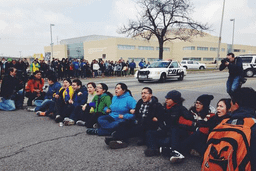For a viable model of “21st century socialism,” many progressives look to Latin America’s Leftward surge. But swept up in the continent’s “pink tide” are questions of indigenous land and resource rights, which often clash with state development priorities. From Venezuela to Bolivia to Chile, indigenous communities are charging that they have been betrayed by the populist presidents they helped elect.
Ben Dangl, author of Dancing with Dynamite, notes that the tension between indigenous social movements and pink tide politicians stems from these governments’ reliance on resource extraction to generate income. He told In These Times via e-mail:
For many of Latin America’s new leftist governments, the logic of the state-run extractive industry consistently runs against the rhetoric and rights of respecting the environment and indigenous autonomy. This contradiction has played itself out in many cases across the region, from mining in Venezuela [under President Hugo Chavez], to oil exploitation in Ecuador [under left-of-center President Rafael Correa].
The grandiose rhetoric of Latin American populism often fails indigenous communities who don’t see themselves as part of a national project. But as movements ratchet up struggles against environmental and cultural destruction, they must confront a narrative of economic progress — and, often, face down harsh repression.
The Isiboro Sécure National Park and Indigenous Territory (TIPNIS) is a protected reserve over 10,000 indigenous people call home. Its muddy waters and breathtaking green vistas reign over a swath of Bolivia, home to Latin America’s first indigenous head-of-state. But after sweeping into office and taking the extraordinary gesture of bestowing rights on “Mother Earth,” Evo Morales has made a surprising about-face by contracting the Brazilian firm OAS to build a 182-mile highway straight through the heart of TIPNIS. Heavily opposed by indigenous movements, the road was approved last month. But its future remains indefinite.
Carwil Bjork-James, a PhD candidate studying Bolivian social movements at City University of New York, says that the indigenous movements that carried Morales into office are increasingly disillusioned by the contradiction that Morales has come to embody. Though he has called repeatedly for greater consultation with indigenous movements, Morales has also deployed the power of the state to repress them. Throughout the consultation process, officials have pushed an either/or solution on indigenous residents: either the highway project will be completed, or the zone will be declared what Bjork-James calls an intangible economic zone. If TIPNIS is declared as such, other activities that generate revenue for residents - like sustainable logging and ecotourism - will be disallowed, leaving inhabitants with even more limited options for generating income.
In 2011, when indigenous protestors took to the streets in opposition to the highway, organizing slow pilgrimage-like marches through the region, they relied on their “moral credibility as the original inhabitants of the country,” Bjork-James says, to garner support.
But the Morales administration soon took to the offensive. According to Bjork-James, high-ranking members of the government accused anti-highway activists of acting at the behest of USAID. “The government and the movement separated,” he says. “It has reached a crisis point around the TIPNIS controversy and the events that led to that separation.”
By 2011, a TIPNIS march was met with outright repression when police tried to “arrest an entire march. [They] arrested hundreds of people. High-ranking indigenous leaders were severely beaten, some hospitalized. Some of the people who were in there were indigenous members of Parliament, and they were also arrested,” Bjork-James added.
The Morales government went one step further when the President appeared on television during the TIPNIS march to repeat the USAID accusations and claimed the activists were secretly rightwing. “The indigenous who oppose the road are being confused,” Morales has said, later adding that they cannot truly be his indigenous brothers.
That moment permanently fractured the movement’s ties to the government. But shortly after the outburst, Morales put the planned road on hold, first in October 2011 and again in April of this year due to construction delays.
Then in early October, Morales signed a contract authorizing the first stretch of the trans-TIPNIS highway. The government-community consultations are now in their finals days. And though the feasibility of the project relies heavily on the community dialogues, Morales has said the highway is only “in pause” mode, leaving little doubt that the government expects the consultation process to end in its favor.
Bjork-James says indigenous movements have vowed to fight the highway “to the death.”
In Chile, indigenous Mapuche can claim a lengthy history of struggle stretching back into the pre-Columbian period. Mapuche territory south of the Bio-Bio River was the last bit of the coastal country to be incorporated into the state, not becoming governable in any practical sense until the late in the 1800s. Since that time, the Mapuche have been embroiled in land struggles with both corporations and the Chilean state.
In an effort to recoup their lands from successive presidential administrations, the Mapuche have resorted to increasingly radical tactics such as reoccupying lands and sabotaging corporate equiptment.
Former Chilean President Michelle Bachelet, a pink tide politician who was herself detained under the Pinochet dictatorship, used a dictatorship-era anti-terrorist law to repress Mapuche activists. The law extends the definition of terrorism to include property violence, allows for civilian cases to be tried in military courts and permits the use of anonymous witnesses by prosecutors.
In the Mapuche context, the far-reaching law can be used to sentence activists to lengthy sentence for an array of crimes that wouldn’t normally be considered “terrorism,” from torching corporate crops planted on their lands to carrying weapons.
On October 8, current Chilean president Sebastián Piñera signed an executive order establishing an Indigenous Development Area (IDA) — defined as “territorial areas where state agencies will focus action in favor of the harmonious development of indigenous people and their communities” — in the town of Erskine. Thirty-seven Mapuche communities have accepted the order, but five are refusing to participate in the new scheme. Nine Mapuche activists are being detained for attempted murder, illegal carrying of firearms and other charges that their supporters say are trumped-up or politically-motivated.
Jorge Huenchullán, spokesman, for the Temucuicui community, told Upside Down World that the government is trying to paper over this issue. He added that the IDAs are:
Part of the administration’s strategy to cover up the real conflict, which is the complete recovery of the lands demanded by the communities, and to cover up a series of violent abuses and deny the protests that we are staging here in Ercilla´s Mapuche communities. We Mapuche are not looking for handouts for our people, so we reject the ADI. It does not apply to us.
Dangl told In These Times that he sees a radical potential in indigenous demands. Andean indigenous movements, he explained, have long proposed “buen vivir,” or “living well,” as a solution to crisis. “The concept is roughly translated into a respect for this rights of Mother Nature, an idea of social progress which isn’t based on greed, the depletion or national resources and the pollution of the environment,” Dangl says. The idea is supported by the policies, if not the actions, of national governments in heavily-indigenous Ecuador and Bolivia.
“Here is a case where a vision, history and politics of certain indigenous movements,” Dangl says, “could have an impact on regional and even international debates around how we overcome capitalism and move toward a more just and sustainable world.”
Nyki Duda is a freelance editor and writer. She currently researches misinformation at Lead Stories. Her work has appeared in Dissent, The Progressive and more. Nyki is a former broadcast script editor and has a master’s degree in anthropology.




